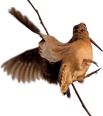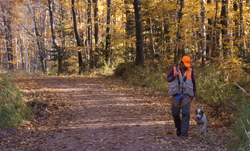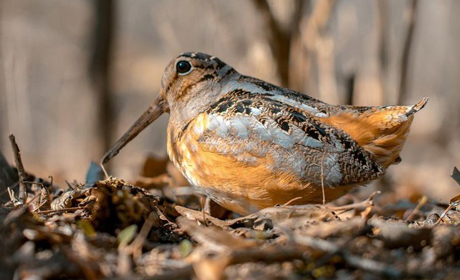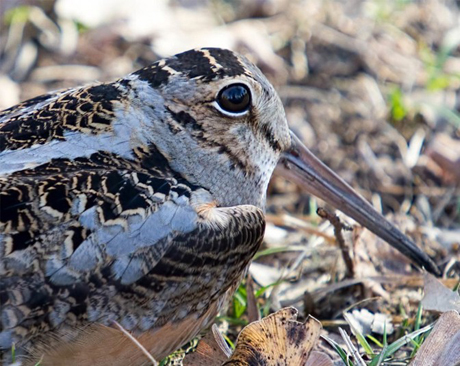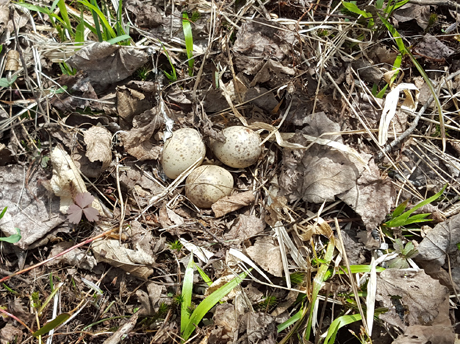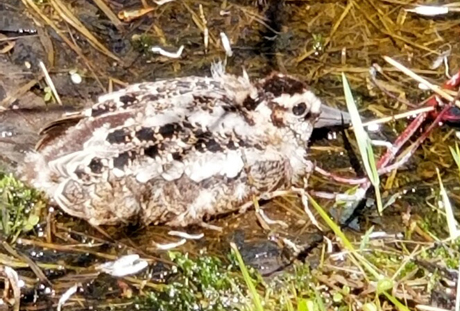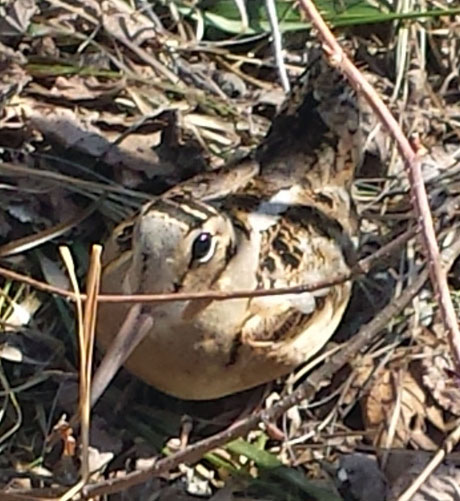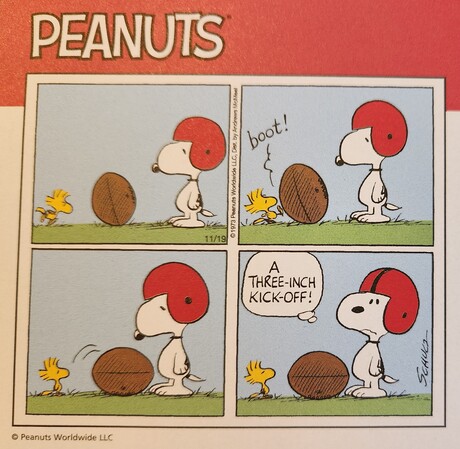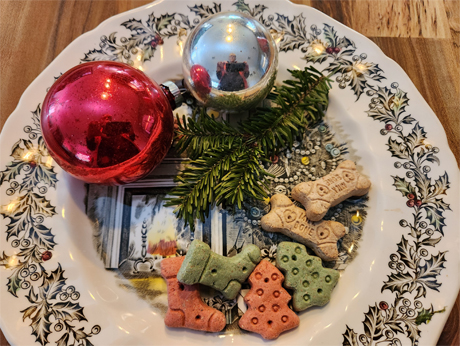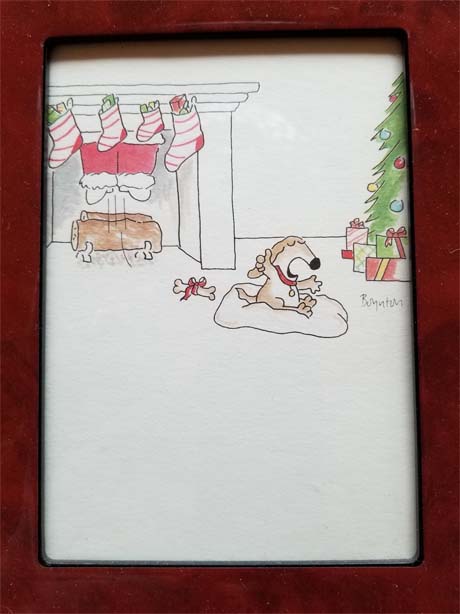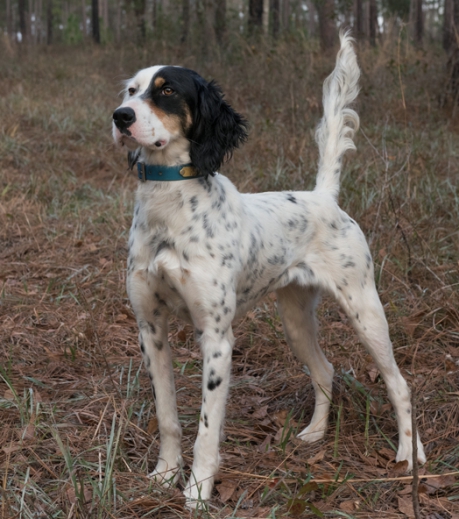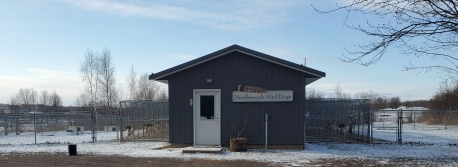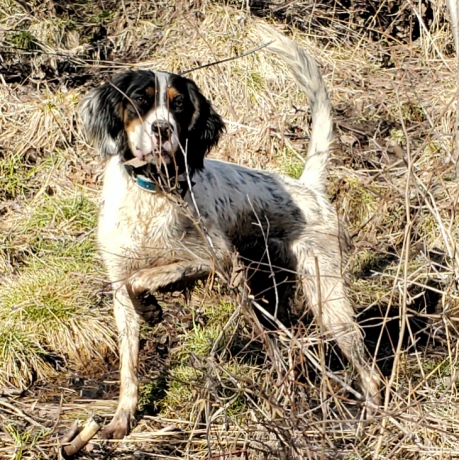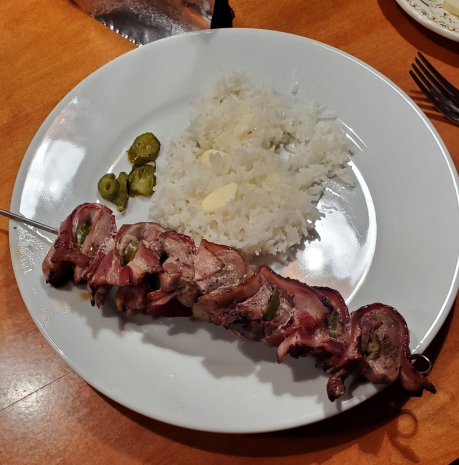American Woodock (Scolopax minor)
On a cold, cloudy day in late March, Jerry and I took our one-year-old female setter Dilly (CH Woodville’s Yukon Cornelius x Northwoods Redbreast, 2024) to a nice woodcock spot of young aspen and sparse undergrowth.
Dilly was exuberant—whether due to her age or the conditions or both—but we knew she was hunting. We were all rewarded when, within about 20 minutes, we found Dilly on point.
The woodcock were back!
For many upland hunters and dog owners, the return of the woodcock is an important part of the natural rhythm of things. It confirms the seasonal shift from winter to spring.
And how can one not be excited about that return? How can one not be enchanted by woodcock and delight in their oddities? There aren’t many birds that have a cuter, rounder body or a longer beak. Breast meat is dark and leg meat is white. A woodcock’s brain is, basically, upside down. Ears are placed under its eyes, which are situated far back on its head.
And those eyes! In “Making Game: An Essay on Woodcock,” Guy De La Valdene writes that a woodcock’s eyes are “black and limpid, not eyes to dwell on if one intends to keep hunting.”
Taxonomy
The scientific name of the American woodcock is Scolopax minor. It is the only upland bird in the large Scolopacidae family, a major shorebird family. Other members include sandpipers, curlews, godwits, dowitchers and snipe.
Besides the American woodcock, there are seven other members of the Scolopax genus. Eurasion woodcock, S. rusticola, is native across Europe and Asia from Ireland to Japan. There are six other species, each native to their own small island.
All family members are ground nesters and usually the nest is just a scrape. It might not seem like ample protection but the camouflage is ideal. Generally, 2-4 eggs are laid and are colored and spotted to blend in. At birth, precocial young are covered with down and, with the help of a parent, are mobile enough to leave the nest within hours.
Evolution
Birds date to the Cretaceous period (135 – 66 million years ago) of the Mesozoic era, a.k.a., the age of dinosaurs. Birds with beaks survived the asteroid-induced mass extinction at the end of that period most likely because they could eat plants.
The first woodcock fossil discovery was from about 20 million years ago. When the glaciers began retreating during the later Pleistocene epoch of the Cenozoic era (about 20,000 – 30,000 years ago), woodcock followed. They ended up in their current locales at the end of that retreat.
Range and Habitat
The woodcock population in the U.S. is divided into two major groups: Eastern (from the Appalachian Mountains to the east) and Central (west of the Appalachians to western edge of the Minnesota/Iowa/Missouri borders). The Eastern birds generally migrate along the Atlantic coast and the Central population usually follows the Mississippi River.
Woodcock like successional deciduous forests where there is rich soil. In addition, they need open areas–fields, grasslands or forest cleanings–and shrubby areas.
Woodcock roost, forage and practice their mating ritual—the sky dance—in open areas. They move to the cover of a forest during the day to forage and to avoid predation.
Avoiding predation
A woodcock’s prime methods of predator evasion are not moving and camouflage. Countless times while training young dogs, Jerry and I would stop to listen for the bell of the errant dog. Within about a minute and usually no more than 15 feet away, a woodcock flushed, thinking we had moved on.
A woodcock’s approximately 1,000 feathers are flawlessly arranged in various patterns that perfectly mimic the accumulated detritus of the forest floor. The colors of those feathers, as described in De La Valdene’s book, include “cream, cinnamon, ochre, black, burnt umber, raw sienna, brown and auburn” and five shades of gray.
Fun facts about food, nesting and migration
• Males and females have similar feather arrangement and colors. Females, called hens, are a little larger and have slightly longer wings and bills.
• Woodcock are solitary birds and except when breeding or rearing chicks spend their days alone.
• Woodcock eat worms…lots of worms. Estimates vary but somewhere between 60-90% of their diet is worms, which are high in protein, fat and water. Other foods include insects, grubs and larvae.
• When walking through the woods, woodcock bob and rock back and forth and look, somewhat, like they’re dancing the two-step. One theory is they are causing vibrations in the soil which can cause worms to come to the surface.
• In addition to peents and chirps of the sky dance, males cackle to warn off other males. A whistle noise is made by their fast-beating wings, such as when they flush.
• Snow and heavy rains during nesting can be detrimental.
• When woodcock eggs hatch, the eggs are split lengthwise.
• Hens will use the “broken wing” trick to lure predators away from their nests.
• Woodcock take it easy when they migrate. In general, they’re not rushing either north or south and often are the last bird to migrate in the fall.
• Snowstorms, thunderstorms and strong winds impact migration. Woodcock will simply wait for the weather to improve before continuing.
Saving the best for last: The Sky Dance
Most male members of the Scolopacidae family have some sort of aerial display for breeding. Woodcock are renowned for their ritual, nicknamed the “sky dance.” I’ve heard it many times and in many spring seasons around our house and kennel.
Aldo Leopold exquisitely describes it in “A Sound County Almanac.”
“He flies in low from some neighboring thicket, alights on the bare moss, and at once begins the overture: a series of queer throating ‘peents’ spaced about two seconds apart, and sounding much like the summer call of the nighthawk.
“Suddenly, the peenting ceases and the bird flutters skyward in a series of wide spirals, emitting a musical twitter. Up and up he goes, the spirals steeper and smaller, the twittering louder and louder, until the performer is only a speck in the sky. Then, without warning, he tumbles like a crippled plane, giving voice in a soft liquid warble that a March bluebird might envy. At a few feet from the ground he levels off and returns to his peenting ground, usually to the exact spot where the performance began, and there resumes his peenting.”

